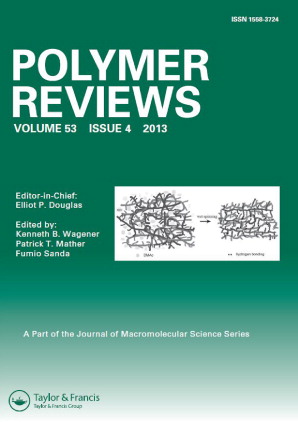Polymer Reviewsboasted an Impact Factor of 7.794 in the 2012 Journal Citation Report® (JCR) in which it was ranked second in the Polymer Science category out of 83 journals, reflecting the quality of the work included in the journal. Polymer Reviews publishes reviews on topics of current interest in all areas of macromolecular science and engineering.
Polymer Reviews was the focus of a 2011 Editors' Bulletin Impact Factor Story with previous Editor Professor Elliot P. Douglas. The article can be found here: http://dx.doi.org/10.1080/17521742.2011.609384.
Why do you think the journal has seen such a good Impact Factor? Has it resulted from any changes in editorial policy?
I believe that the high and increasing Impact Factor for our journal can be attributed to three factors – first, the field of polymer science is continuing to grow, particularly in the area of application development; second, the quality of our review articles is quite high and research-active readers are finding utility in their content; and third, our themed issues (introduced by former Editor-in-Chief Elliot Douglas) bring a new level of article accessibility and synergism among similar articles.
What developments in your research area have contributed to the recent Impact Factor growth?
Polymeric materials are expanding their reach in a large number of commercial sectors that range from medicine to the environment and energy. Upstream fundamental research and applied research related to these application areas, often revealing new and exciting basic findings related to our field. New synthetic methods, polymer architectures, processing methods, and physical properties all inject an overall forward-looking optimism for our field, which is reflected in the Impact Factor growth.
Have you seen any change in the geographical profile of authors in recent years?
Aside from a general climb in submissions from China, which I believe is common across many disciplines, we have not noticed a significant change in the geographical profile in recent years for our authors.
Is your journal supported by a learned society or research institution?
No.
Are you currently rolling out initiatives that may improve the Impact Factor in the future?
Yes! We have several initiatives planned for the future, including “Where are We Now?” review updates for our most impactful review articles, online video content with messages from the authors or Guest Editors, and engagement with social media to spread the word about our content as it emerges.
What role do you feel your journal plays in your research community?
As a review journal, we serve the polymer community as an entry point for researchers new to various subfields. For example, a polymer scientist who has focused on biomaterials and tissue engineering but now wants to explore polymers for energy applications can turn to our journal for highly efficient, focused reviews on that subject matter.
What are the exciting areas of research to watch in the field?
Our readers seem very excited about multifunctional, active polymers, polymers for medical applications, and energy and environmentally pertinent polymeric materials. These are the fields to keep an eye on!
What do you hope the journal will achieve over the next five years?
Over the course of the next five years, I envision Polymer Reviews growing its use of themed issues, increasing its reach to “niche” fields of materials science, and adding features that improve its accessibility through the use of video content, press releases, and social media.
Additional information
Notes on contributors

Patrick T. Mather
Patrick T. Mather earned his B.S. (1989) and M.S. (1990) degrees from Penn State in Engineering Science and Mechanics, following which he went on to receive his Ph.D. in Materials at U.C. Santa Barbara in 1994. He then worked for the Air Force Research Lab until 1999, focusing on polymeric nanocomposites. Mather's academic career began at the University of Connecticut, Chemical Engineering, in 1999. There, he focused on polymeric materials science, studying liquid crystalline polymers, hybrid inorganic-organic polymers, and fuel cell membranes. Having received tenure, Mather then moved to Case Western Reserve University where he established a research program on functional biomaterials. In the Fall of 2007, Pat was recruited to Syracuse University, as the Milton and Ann Stevenson Professor of Biomedical and Chemical Engineering. As director of the Syracuse Biomaterials Institute, he has built a sustainable, interdisciplinary effort with 20+ faculty spanning three institutions and seven departments, along with a brand-new central research facility in renovated space that combines the unique interdisciplinary demands of biomaterials research. Mather's research interests center around smart materials, including shape memory polymers, self-healing materials, polymeric nanocomposites, and biodegradable polymers for medical devices.
Pat is the author of over 150 peer-reviewed papers, inventor on more than 35 patents, and Fellow of both SPE (Society of Plastics Engineering) and the AIMBE (American Institute for Medical and Biological Engineering). Pat holds the prestigious position of Editor-in-Chief for Polymer Reviews and was formerly Associate Editor of Polymer Bulletin. He has won three student-nominated teaching awards and prides himself on innovative and engaging teaching methods. He enjoys traveling the world to give scientific lectures and has delivered over 160 invited lectures to date.
